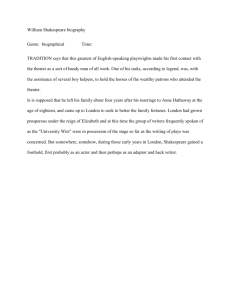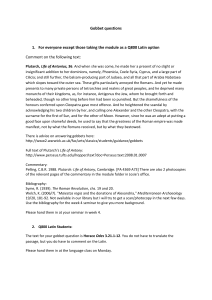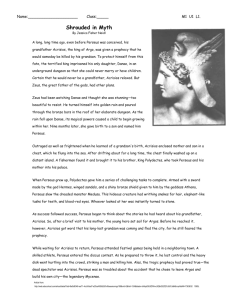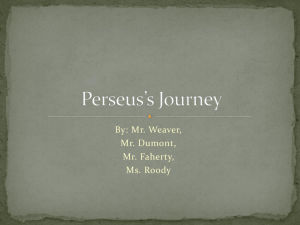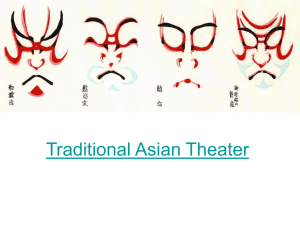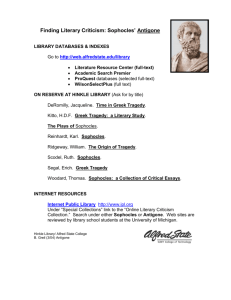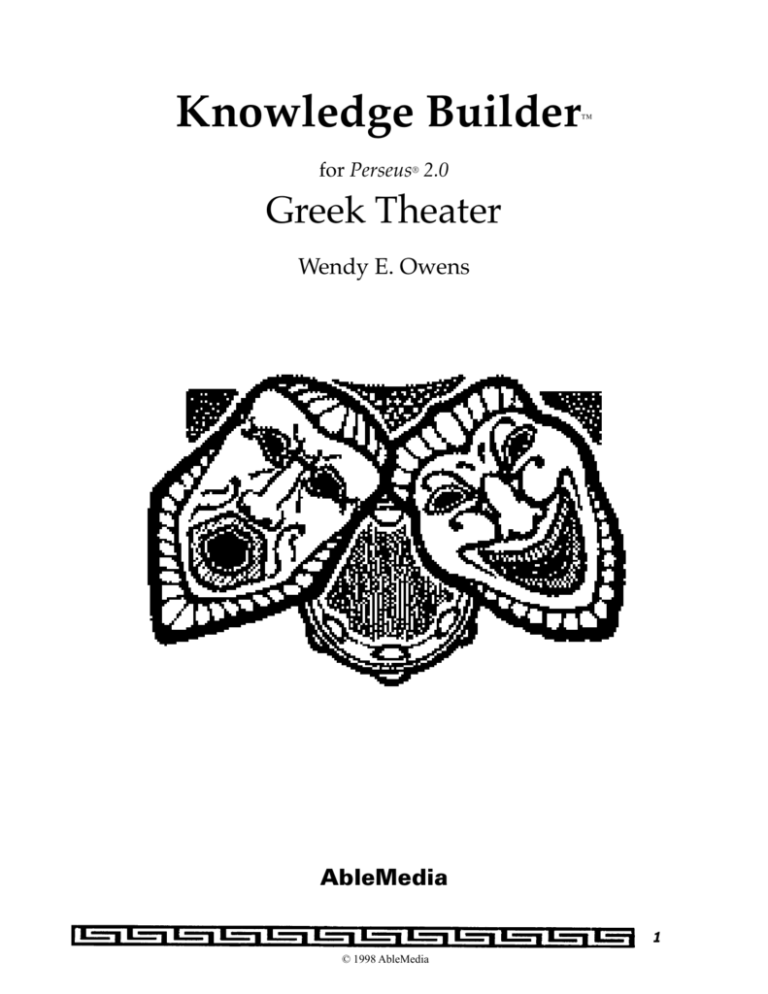
Knowledge Builder
™
for Perseus® 2.0
Greek Theater
Wendy E. Owens
AbleMedia
1
© 1998 AbleMedia
Knowledge Builder
™
for Perseus® 2.0
Greek Theater
Wendy E. Owens
Copyright © 1998 AbleMedia
50 Clark Street, Medford, MA 02155-4474
All Rights Reserved
No part of this assignment may be reproduced by any mechanical, photographic, or electronic process, or
in the form of a phonographic recording, nor may it be stored in a retrieval system, transmitted, or
otherwise copied for public or private use, without the written permission from the publisher.
Printed in the United States of America.
Perseus is a registered trademark of the President and Fellow of Harvard College and
the Corporation for Public Broadcasting.
All copyright are the property of their respective owners.
2
© 1998 AbleMedia
Knowledge Builder
™
for Perseus® 2.0
Greek Theater
Wendy E. Owens
About Knowledge Builders
Knowledge Builders are step-by-step instructions for expanding your knowledge of the
Perseus software and the ancient Greek world. Each Knowledge Builder addresses a
particular topic related to the ancient Greek world. Knowledge Builders provide students and teachers with start up information on a topic and directions for finding information available on that topic in Perseus.
• Knowledge Builders assume that you have completed the assignments of the Quick
Start System™ or that you have a working knowledge of Perseus and a Macintosh.
• Each Knowledge Builder provides you with a list of Further Reference in Perseus for
topics related to the main topic of the Knowledge Builder.
• Each Knowledge Builder provides you with an annotated bibliography of works
relating to the main topics associated with the title of the Knowledge Builder.
• Knowledge Builders make an effort to use Vase, Coin, Site, Sculpture and Architecture Catalog cards in which Universal Images can be found. By using these Catalog
cards, Concise version users can see large images and will learn which Catalog cards
use Universal Images.
• Knowledge Builders get you started using Perseus and get you thinking with a large
academic database. The methods for investigation used in Knowledge Builders are
suggestions and other methods may be applied. You must come up with your own
methods for making the most efficient use of Perseus.
3
© 1998 AbleMedia
Begin this Knowledge Builder™ from the Perseus Gateway.
1. From the Perseus Gateway, click once on the “Tools and Reference” icon. Then click
on “Alphabetical Index” under the heading “Encyclopedia.”
2. Choose the letter “T” from the alphabet at the bottom of the Encyclopedia Index. A
list of terms beginning with the letter “T” will appear.
3. Scroll through this list until you find “Theater.” Click once on the word “Theater” to
see it’s Encyclopedia entry.
This entry offers some basic information on the structure and uses of ancient Greek
theaters. Notice that other terms associated with “Theater” appear in the “See Also”
column.
4. Read the information on ancient Greek theater.
4
© 1998 AbleMedia
5. Click once on “Theater” under "Views" to see an architectural drawing of a Greek
theater.
Remember, close the image when you have finished looking at it.
6. The “See Also” column includes a list of theater parts. Choose the Encyclopedia
entry for “Orchestra” by clicking on “Orchestra” in the “See Also” column.
7. Read through this information. Notice that the center of the orchestra is called the
thymele, meaning “a place for sacrifice, an altar.”
Did the Greeks combine religion with their entertainment? Actually, they did. The Historical Overview has information on the religious, entertainment and political aspects of
ancient Greek theater. From the Historical Overview, you can learn about the nature,
spectacle and performance of tragedy and comedy.
8. Choose “Historical Overview” from the menu under the word “Links” at the top of
the screen by highlighting the word.
5
© 1998 AbleMedia
9. You will now be at the “Historical Overview Table of Contents.” Scroll through the
list until you reach “10.2 The Development of Tragedy.”
10. Click once on the words “10.2 The Development of Tragedy.”
11. Read through the information found on this topic card.
12. A dark gray line will appear under the words “god Dionysos.” Move the mouse
arrow onto this word and hold down your mouse button.
13. From the menu that appears under the words “god Dionysos,” choose “Dionysos
sailing [View].” Close the image when you are done.
14. To move to the next topic card on ancient Greek theater in the Historical Overview,
use your right page turning arrow on your Navigator. Click one time to turn one
page.
6
© 1998 AbleMedia
15. Read “10.2.1 Nature of Tragedy.” What is the Greek word for tragedy?
Even if you do not study the ancient Greek language you can use the Greek tools in
Perseus to find out what an ancient Greek word means. If you can type English, highlight and click then you can look for the Greek equivalents to English words and find
their meanings. Follow the next few steps to learn how.
16. Click once on the “Gateway” icon on the Navigator.
17. Click once on the “Tools & Reference” icon on the Gateway.
18. Under the bold “Philological Tools” heading, click once on “English-Greek Word
Search.”
19. Set the cursor on the line next to the “Look up” command button.
20. Type in the word “tragedy.”
21. Choose “This word only” from the pop-up menu button next to “as.”
22. Click once on the “Look Up” command button.
Remember, give Perseus something to do and
then give it a command.
A list of Greek words whose definitions include the word “tragedy” will appear in the left
column. In this list you will find a word that resembles the English word “tragedy.”
7
© 1998 AbleMedia
23. Highlight the Greek word as seen below.
24. Choose “Greek English Lexicon” from the “Related Tools” pop-up menu button.
The Lexicon will appear with the definition for the word “tragedia.” Notice that the word
refers to a “goat-song” perhaps because the prize for a winning a tragedy competition
was a goat or because the actors in a tragedy wore goatskins during performances. To
find out more about the actual performance of tragedy, go back to the Historical Overview.
25. Choose “Historical Overview” from the menu under the word “Links” at the top of
the screen by highlighting the word.
26. Then find “10.2.2 The Performance of Tragedy” in the Table of Contents. Go there
by clicking on the words “10.2.2 The Performance of Tragedy.”
8
© 1998 AbleMedia
As you read through the information in each Historical Overview topic you will find
useful information. If you would like to use this information in the future, you should
abbreviate it by putting it into note form. Sample notes for the topic “10.2.2 The Performance of Tragedy” appear below.
Details of Performance
1. Main festival for Dionysos held once a year.
2. Three playwrights presented four plays each.
3. Judges awarded prizes at the end of the festival for first, second and
third place.
4. Performances took place during the day, outdoors.
5. Theater of Dionysos held 14,000 spectators.
6. All tragedies had to have the same size cast.
7. Chorus performed dances and songs though leader may have spoken to actors.
27. Look at the “Aerial view” of the theater of Dionysos found under the words “Theater below acropolis [View].” Make sure the command button in the upper right
corner reads “Hide Links/Unlock Text.”
28. After closing the image, turn the page to the next topic card using the right page
turning arrow on your Navigator.
9
© 1998 AbleMedia
Notes can be made for this topic card similar to the ones below:
1.
2.
3.
4.
Actors wore mask.
Actors projected their voices to reach audience in back rows.
Special effects were used, i.e. flying.
Protagonist most important actor, chosen by lot and assigned to each
playwright competing for 1st prize.
You can take notes on paper or type them into a word processing program while using
Perseus. The Knowledge Builder™ “How to use Perseus with a Word Processing Program” tells you how.
If actors wore masks, what did the masks look like? What were they made of? These
questions can be answered by going through the next few steps.
Some of the most elaborate and decorative costumes were worn by actors. In ancient
Greek theater the actors were men. Men had to play the roles of women and therefore
had to dress like them. Perseus covers theater costumes well through both textual and
archaeological information. The combination of such information allows you to better
understand the play you are reading. Aeschylus made sure his actors wore grand
costumes and Aristophanes even dressed his players up as “Birds.”
The “Birds” from Aristophanes’ play of the same title appear in costume on the next
vase.
29. Choose “Browser” from the Links menu.
30. Click once inside the radial button next to Vases.
31. Choose “Keywords” from the first pop-up menu button.
10
© 1998 AbleMedia
32. Choose “Other Terms” from the second pop-up menu button.
33. From the list of “Other Terms,” choose “Aristophanes’ Birds.”
34. From the list of vases, click once on “Malibu 82.AE.83.”
35. You will now be at the Catalog card for “Malibu 82.AE.83.”
36. Look at the image “Side A: scene from Aristophanes’ Birds.”
You will also want to examine the drama masks in the text of Aeschylus’ Encyclopedia
entry and the Historical Overview topic 12.2.3 The economic effects of war on Athenian
women and 12.2.5 Athenian Comedy during the war. Below you will look at a mask
mosaic from Delos’ House of the Masks.
37. Return to the Perseus Gateway by clicking once on the Gateway icon on your Navigator.
38. Click once on the “Art & Archaeology” icon.
11
© 1998 AbleMedia
39. Click once on “Index by Site” under the Architecture heading.
40. You will now be at the Architecture Index card.
41. Click once on “Delos” in the left column.
42. Click once on “Delos, House of Masks” in the right column.
43. Look at the view “detail of floor mosaic, a mask.”
You have seen a theater, masks and have taken notes on the performance aspects of
theater but where were the theaters? To answer this question you will have to go to the
Atlas Link in Perseus.
12
© 1998 AbleMedia
There are nine Greek theaters that appear in Perseus at the following sites:
Amphiaraion, Assos, Athens, Delos, Epidauros, Eretria, Miletus, Piraeus and Priene.
The theaters at these sites can all be viewed in the Perseus Architecture Link. To see
each theater you will have to go to the Architecture Index and look up the architecture
by “Type.” Right now follow the next few steps to plot these sites in the Atlas.
44. Choose “Atlas” from the Links menu.
45. You should now be at the “Outline” map of the Perseus Atlas.
46. Move your mouse arrow onto the “flag” next to “Show Tools” in the lower right
corner of the Tools Palette and click once on the flag so that the bottom drops out of
the Tools Palette.
47. Move the Atlas Tools Palette to one side of the Atlas map.
48. Click once inside the radial button next to “Plot Sites.”
49. Scroll down through the site list to “Amphiaraion.”
50. Click once “Amphiaraion” so that it is highlighted.
51. Click once on the command button “Plot Selected Sites.”
Plot the other sites listed above using these steps. Why do you think the sites are so
close together?
52. Choose “Historical Overview” from the menu under the word “Links” at the top of
the screen. Then find “10.2.4 Tragedians” and go to this topic card.
13
© 1998 AbleMedia
From reading the information found in this topic card you learn that a tragedian acted as
author, director, producer, choreographer, musical composer and sometimes even actor
of his own plays. Usually the tragedians were of the wealthier type, men who could
afford the time to be involved in a production. Tragedians had to meet the political and
military requirements of every Athenian male. The best known Athenian tragedians are
Aeschylus, Sophocles and Euripides.
53. Choose “Grave of Aeschylus [text]” under the words “Under this stone lies
Aeschylus the Athenian, son of Euphorion ... the grove at Marathon and the Persians who landed there were witnesses to his courage.”
Read this passage, beginning at section 5 to the end of the section. Notice that
Aeschylus’ military service and valor appear to have meant more to him than his victories at the tragedy contests. Why might have this been the case?
54. Choose “Encyclopedia” from the menu under the word “Links” at the top of the
screen by highlighting “Encyclopedia.”
55. Choose the letter “S” from the alphabet at the bottom of the Encyclopedia Index. A
list of terms beginning with the letter “S” will appear.
14
© 1998 AbleMedia
56. Scroll through this list until you find “Sophocles.” Click once on the word
“Sophocles” to see his Encyclopedia entry.
57. Scroll through this entry to the heading “Birth and Death.”
Read through the information on the life of Sophocles, notice how little concrete and
substantiated evidence is available on his life. It is hard to figure out which are the facts
and which are made-up stories that cause Sophocles’ life to seem even more colorful.
Biographies for each author whose works appear in Perseus can be accessed through
the Encyclopedia. For more information on Aeschylus and Euripides see their Encyclopedia entries.
58. Go to the Historical Overview topic “10.2.5.1 Sophoclean Success.”
15
© 1998 AbleMedia
A great deal of summarized information on Sophocles, his life and work is available in
the 10.2.5.1-10.2.5.4 topic cards. If you intend to do an in-depth report on Sophocles,
these topic cards would give you a solid knowledge base on which you could build a
strong argument with the information found in Perseus and other outside sources.
Comedy in Perseus
Perseus contains the works of the Greek comic playwright, Aristophanes and information on comedy as a vehicle for social commentary. You should look at the following
topics in the Historical Overview for more information:
12.2.5 Athenian Comedy during the War.
12.2.6 The humor and plots of Athenian Comedy.
12.2.7 Comedy as criticism of official policy.
12.2.8 The Lysistrata of Aristophanes.
59. Choose “English Index” from the Links menu.
60. Move the arrow onto dotted line next to “Look for.” Click once on the mouse
button to set cursor (|).
61. Type the word “Comedy” next to the words “Look for.”
62. Choose “Top of List” from the pop-up menu button next to “Show List at.”
63. Choose “Exact Match” from the pop-up menu button next to “Position.”
64. Move the mouse arrow onto the “Do Search” button and click once. It will
take a few seconds to complete the search.
65. The results of the search will appear in the search results space.
16
© 1998 AbleMedia
66. Highlight the words “Aristophanes (encyclopedia)” in the list of citations.
Then click once on the command button “Go There.”
67. Read the Encyclopedia entry for Aristophanes.
68. Choose “Lookup” from the Links menu at the top of the screen.
69. Type “Paus. 1.21.1” in the Lookup box and choose “Primary Text” from the Links
menu.
You will now be at Pausanias’ Guide to Greece, Book 1 section 21.1. Read from 21.121.2 on the Athenian theater in which statues were erected of tragedians and comic
playwrights. Why might the Athenians erect statues of playwrights, famous and undistinguished? Think about what you have read in the Historical Overview topic cards on
tragedy and comedy.
Congratulations! You have finished this Knowledge Builder! Review
any steps with which you do not feel comfortable.
17
© 1998 AbleMedia
Further References
Below you will find a brief listing of Coins, Architecture, Vases, Primary Text, Encyclopedia entries and Sites relating to the bolded topic. These lists are the results of English
Word Searches for each of the bolded topics.
You can go to all these citations, except for Primary Text entries, without having to
perform an English Word Search. Follow the directions below.
•
•
Highlight “Lookup” under the Links menu at the top of the screen.
Type a citation into the “Lookup” box and highlight the corresponding Link for that
citation, i.e. type “Harvard 1959.123” and highlight “Vases” under Links at the top of
the screen.
Theater
Architecture: at Amphiaraion: Klepsydra, Stoa, Theater; at Assos: Theater; at Athens:
Sanctuary of Dionysos Eleuthereus, Theater of Dionysos, Doric Stoa near Theater of
Dionysos, New Bouleuterion, Sanctuary of Dionysos Eleuthereus; at Delos: House of
the Masks, House of the Trident, Monument of Mithridates, Samothrakeion, Temple of
Hera, Temple of Isis, Temple of Serapis, Temple to Egyptian Gods, Theater; at Delphi:
Lesche of the Knidians, Monument of the Thessalians, Stoa of Attalos I, West Stoa; at
Epidauros: Katagogeion, Odeion, Stadium, Theater; at Piraeus: Theater of Zea.
Primary Texts: Herodotus, Histories; Pausanias, Description of Greece, Books 1-10;
Plutarch’s Aristides and Cimon.
Encyclopedia: Acarnania, Aetolia, Arcadia, Argolid, Attica, Auditorium, Cavea,
Corinthia, Cunei, Diazomata, Dodecanese, Epirus, Episkenion, Ikria, Kerkis, Laconia,
Logeion, Macedonia, Magnesia, Messenia, Odeion, Orchestra, Parados, Plutarch,
Prohedria, Skene, Theater, Theatron, Theologeion, Thymele, Thyromata.
Historical Overview: TRMartin History 12.2.5, TRMartin History 10.2.5.2.
Sites: Amphiaraion, Assos, Delphi, Epidauros.
Tragedy
Primary Texts: Apollodorus, Library Books 1-3, Epitome; Pausanias, Description of
Greece, Books 1-10; Plutarch’s Pericles, Solon Themistocles;
Encyclopedia: Aeschylus, Chelys-Lyra, Kithara, Lyre, Pindar, Sophocles.
Historical Overview: TRMartin History 10.2, TRMartin History 10.2.1, TRMartin History 10.2.2, TRMartin History 10.2.3, TRMartin History 10.2.4, TRMartin History 10.2.5,
TRMartin History 10.2.5.1, TRMartin History 10.2.5.2, TRMartin History 10.2.5.3,
TRMartin History 11.1, TRMartin History 12.2.5, TRMartin History 12.2.8.
Comedy
Primary Texts: Apollodorus, Library, Books 2-3, Epitome; Pausanias, Guide to Greece,
Books 1 & 5; Plutarch’s Cimon.
Encyclopedia: Aristophanes, Aspasia, Sophocles.
Historical Overview: TRMartin History 12.2, TRMartin History 12.2.5, TRMartin History 12.2.6, TRMartin History 12.2.7, TRMartin History 14.10.
18
© 1998 AbleMedia
Actor
Primary Texts: Aeschylus, Seven Against Thebes; Apollodorus, Library Books 1-3;
Homer, Iliad and Odyssey; Pausanias, Guide to Greece, Books 1, 3, 5, 6, 8, 9; Pindar, Olympian Ode 9; Plutarch, Alcibiades, Lyssander.
Encyclopedia: Skene, Theologeion.
Historical Overview: TRMartin History 10.2.3.
Chorus
Primary Texts: Aeschylus, Agamemnon, Eumenides, Libation Bearers, Seven Against Thebes;
Apollodorus, Library Book 3, footnote d; Herodotus, Histories; Pausanias, Guide to
Greece, Book 4; Pindar Nemean Odes 5, 6, Pythian Ode 3; Plutarch, Lysander, Nicias;
Sophocles, Ajax, Antigone, Oedipus Colonus, Oedipus Tyrannus, Philoctetes, Trachiniae.
Encyclopedia: Aeschylus, Coryphaios, Kithara, Orchestra, Skene, Thymele.
Historical Overview: TRMartin History 6.12, TRMartin History 10.2.2, TRMartin History 10.2.3, TRMartin History 12.2.5, TRMartin History 12.2.5, TRMartin History 14.10.
Aeschylus
Primary Texts: Apollodorus, Library Books 2-3, Epitome; Herodotus, Histories;
Pausanias, Guide to Greece, Books 1, 2, 4, 6, 8-10; Plutarch, Aristides, Cimon, Themistocles,
Theseus;
Encyclopedia: Aeschylus, Attica, Parian Marble (Marmor Parium), Pindar, Sophocles.
Historical Overview: TRMartin History 10.2.4, TRMartin History 10.2.5.
Site: Eleusis.
Sophocles
Primary Texts: Apollodorus, Library Books 1-3, Epitome; Pausanias, Guide to Greece,
Books 1; Plutarch, Cimon, Nicias, Pericles; Sophocles, Ajax, Antigone, Electra, Oedipus
Colonus, Oedipus Tyrannus, Philoctetes, Trachiniae; Thucydides, History of the Peloponnesian
War.
Encyclopedia: Aeschylus, Herodotus, Kithara, Pindar, Sophocles.
Historical Overview: TRMartin History 10.2.4, TRMartin History 10.2.5.1, TRMartin
History 10.2.5.1, TRMartin History 10.2.5.1, TRMartin History 10.2.5.1, TRMartin History 10.2.5.2, TRMartin History 10.2.5.3, TRMartin History 10.2.5.4.
Euripides
Vases: London 1947.7-14.18.
Primary Texts: Apollodorus, Library Books 1-3, Epitome; Pausanias, Description of
Greece, Book 1; Plutarch, Cimon, Lysander, Nicias, Solon, Theseus; Thucydides, History of
the Peloponnesian War.
Encyclopedia: Aeschylus, Kithara, Pindar, Sophocles.
Historical Overview: TRMartin History 10.2.4, TRMartin History 11.1, TRMartin History 11.1, TRMartin History 11.1.2.
Aristophanes
Vases: Malibu 82.AE.83.
Primary Texts: Apollodorus, Library Books 1-3, Epitome; Pausanias, Description of
19
© 1998 AbleMedia
Greece, Book 5; Pindar, Nemean Ode 3; Plutarch, Alcibiades, Cimon, Nicias, Pericles,
Themistocles.
Encyclopedia: Aeschylus, Aspasia, Attica, Kithara, Nicias Niceratou Cydantides,
Pindar, Sophocles, Theologeion.
Historical Overview: TRMartin History 9.4.2, TRMartin History 12, TRMartin History
12.2.5, TRMartin History 12.2.6, TRMartin History 12.2.6, TRMartin History 12.2.7,
TRMartin History 12.2.8, TRMartin History 14.10.
20
© 1998 AbleMedia
For more free materials from
AbleMedia, visit the
Classics Technology Center
http://ablemedia.com/ctcweb
50 Clark Street • Medford • MA 02155-4474
(781) 396-7582 • FAX (781) 393-5643
e-mail: ctc@ablemedia.com
http://ablemedia.com/
21
© 1998 AbleMedia

